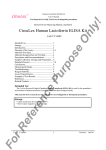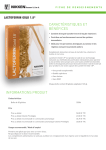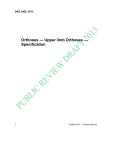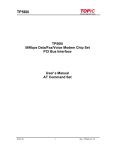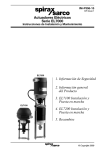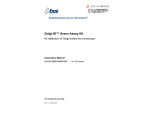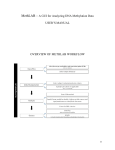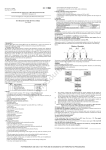Download Anti-Lactoferrin IgG
Transcript
AssayMaxTM Human Lactoferrin Autoantibody ELISA Kit (Anti-Lactoferrin IgG) Assaypro LLC 3400 Harry S Truman Blvd St. Charles, MO 63301 T (636) 447-9175 F (636) 395-7419 www.assaypro.com For any questions regarding troubleshooting or performing the assay, please contact our support team at [email protected]. Thank you for choosing Assaypro. Assay Summary Step 1. Add 50 µl of Standard or Sample per well. Incubate 2 hours. Step 2. Wash, then add 50 µl of HRP Conjugate per well. Incubate 1 hour. Step 3. Wash, then add 50 µl of Chromogen Substrate per well. Incubate 30 minutes. Step 4. Add 50 µl of Stop Solution per well. Read at 450 nm immediately. Symbol Key Consult instructions for use. H G F E D C B A 1 2 3 4 5 6 7 8 9 10 11 12 Assay Template Human Lactoferrin Autoantibody ELISA Kit (Anti-Lactoferrin IgG) Catalog No. EL7011-1 Sample insert for reference use only Introduction Lactoferrin is an 80 kDa iron-binding glycoprotein produced by many exocrine glands with a major constituent in the secondary granules of neutrophilic leukocytes. Serum lactoferrin concentration is much higher during inflammation (1). Lactoferrin is known to be an immune modulator or enhancer due to specific receptors for lactoferrin that are found on many key immune cells such as lymphocytes, monocytes, and macrophages. Lactoferrin is known to be directly involved in the up-regulation of natural killer (NK) cell activity (2). Lactoferrin is present in maternal milk, saliva, tears, vaginal secretions, semen, bronchoalveolar lavage fluid, and specific granules of polymorphonuclear leukocytes (PMNs) (3). Lactoferrin is found mainly in the oral cavity where it can come into direct contact with pathogens such as viruses, bacteria, etc. Lactoferrin directly inhibits viruses by binding to viral receptor sites, thus preventing the virus from infecting healthy cells. Lactoferrin has a direct bactericidal function to certain bacteria such as Streptococcus mutans, Vibrio cholerae, Escherichia coli, Actinobacillus actinomycetemcomitans, and Legionella pneumophila (2-4). Also, it has a bacteriostatic effect that deprives iron-requiring bacteria of this essential growth nutrient (4). Lactoferrin is also considered an antioxidant that scavenges free iron, helping to prevent uncontrolled iron based free radical reactions, thus protecting certain cells from peroxidation (2). Autoantibodies against lactoferrin belong to the pANCA class (Perinuclear Anti-Neutrophil Cytoplasmic Antibodies). Principle of the Assay The AssayMax Human Lactoferrin Autoantibody ELISA (Enzyme-Linked Immunosorbent Assay) kit is designed for the quantitative determination of autoimmune response (IgG) to a target antigen (lactoferrin). The kit detects autoantibodies in plasma and serum samples. This assay employs a quantitative sandwich enzyme immunoassay technique that measures autoantibodies (anti-Lactoferrin IgG) in less than 4 hours. A lactoferrin antigen has been pre-coated onto a 96-well microplate with removable strips. Autoantibody specific for lactoferrin in standards and samples is sandwiched by the immobilized antigen and an antibody-HRP conjugate. All unbound 1 material is washed away and a peroxidase enzyme substrate is added. The color development is stopped and the intensity of the color is measured. Caution and Warning This product is for Research Use Only and is not intended for use in diagnostic procedures. Prepare all reagents (working diluent buffer, wash buffer, standard, HRP conjugate) as instructed, prior to running the assay. Prepare all samples prior to running the assay. The dilution factors for the samples are suggested in this insert. However, the user should determine the optimal dilution factor. Spin down the HRP conjugate vial before opening and using contents. The Stop Solution is an acidic solution. The kit should not be used beyond the expiration date. Reagents Human Lactoferrin Microplate: A 96-well polystyrene microplate (12 strips of 8 wells) coated with lactoferrin. Sealing Tapes: Each kit contains 3 precut, pressure sensitive sealing tapes that can be cut to fit the format of the individual assay. Human Lactoferrin Standard: Plasma standard (100 AU, lyophilized). HRP Conjugate (50x): A 50-fold concentrated HRP-antibody conjugate (120 l). MIX Diluent Concentrate (10x): A 10-fold concentrated buffered protein base (30 ml). Wash Buffer Concentrate (20x): A 20-fold concentrated buffered surfactant (30 ml, 1 bottle). Chromogen Substrate: A ready-to-use stabilized peroxidase chromogen substrate tetramethylbenzidine (8 ml). Stop Solution: A 0.5 N hydrochloric acid to stop the chromogen substrate reaction (12 ml). Storage Condition 2 Upon arrival, immediately store components of the kit at recommended temperatures up to the expiration date. Store HRP Conjugate at -20°C. Store Microplate, Diluent Concentrate (10x), Wash Buffer, Stop Solution, and Chromogen Substrate at 2-8°C. Unused microplate wells may be returned to the foil pouch with the desiccant packs and resealed. May be stored for up to 30 days in a vacuum desiccator. Diluent (1x) may be stored for up to 30 days at 2-8°C. Store Standard at 2-8°C before reconstituting with Diluent and at -20°C after reconstituting with Diluent. Other Supplies Required Microplate reader capable of measuring absorbance at 450 nm. Pipettes (1-20 l, 20-200 l, 200-1000 l, and multiple channel). Deionized or distilled reagent grade water. Sample Collection, Preparation, and Storage Plasma: Collect plasma using one-tenth volume of 0.1 M sodium citrate as an anticoagulant. Centrifuge samples at 3000 x g for 10 minutes. Dilute samples 1:40 into MIX Diluent and assay. The undiluted samples can be stored at -20°C or below for up to 3 months. Avoid repeated freeze-thaw cycles (EDTA or Heparin can also be used as an anticoagulant). Serum: Samples should be collected into a serum separator tube. After clot formation, centrifuge samples at 3000 x g for 10 minutes, and remove serum. Dilute samples 1:40 into MIX Diluent and assay. The undiluted samples can be stored at -20°C or below for up to 3 months. Avoid repeated freeze-thaw cycles. Reagent Preparation Freshly dilute all reagents and bring all reagents to room temperature before use. MIX Diluent Concentrate (10x): If crystals have formed in the concentrate, mix gently until the crystals have completely dissolved. Dilute the MIX Diluent Concentrate 1:10 with reagent grade water. Store for up to 30 days at 2-8°C. Standard Curve: Reconstitute the Standard 100 AU with 1 ml of MIX Diluent to generate a 100 AU/ml standard stock solution. Allow the standard to sit for 10 minutes with gentle agitation prior to making dilutions. Prepare duplicate or triplicate points by serially diluting the standard stock solution (100 AU/ml) 1:2 using equal volume of MIX Diluent to produce 50, 25, 12.5, 6.25, 3.125, and 1.563 AU/ml solutions. MIX Diluent serves as the zero standard (0 AU/ml). Any remaining solution should be frozen at -20°C and used within 30 days. 3 Standard Point P1 P2 P3 P4 P5 P6 P7 P8 Dilution 1 part Standard (100 AU/ml) 1 part P1 + 1 part MIX Diluent 1 part P2 + 1 part MIX Diluent 1 part P3 + 1 part MIX Diluent 1 part P4 + 1 part MIX Diluent 1 part P5 + 1 part MIX Diluent 1 part P6 + 1 part MIX Diluent MIX Diluent [Lactoferrin] (AU/ml) 100.0 50.00 25.00 12.50 6.250 3.125 1.563 0.000 HRP Conjugate (50x): Spin down the HRP Conjugate briefly and dilute the desired amount of the conjugate 1:50 with MIX Diluent. Any remaining solution should be frozen at -20°C. Wash Buffer Concentrate (20x): If crystals have formed in the concentrate, mix gently until the crystals have completely dissolved. Dilute the Wash Buffer Concentrate 1:20 with reagent grade water. Assay Procedure 4 Prepare all reagents, standard solutions, and samples as instructed. Bring all reagents to room temperature before use. The assay is performed at room temperature (20-25°C). Remove excess microplate strips from the plate frame and return them immediately to the foil pouch with desiccants inside. Reseal the pouch securely to minimize exposure to water vapor and store in a vacuum desiccator. Add 50 l of Standard or sample per well. Cover wells with a sealing tape and incubate for 2 hours. Start the timer after the last addition. Wash five times with 200 l of Wash Buffer manually. Invert the plate each time and decant the contents; hit 4-5 times on absorbent material to completely remove the liquid. If using a machine, wash six times with 300 l of Wash Buffer and then invert the plate, decanting the contents; hit 4-5 times on absorbent material to completely remove the liquid. Add 50 l of HRP Conjugate to each well and incubate for 1 hour. Wash the microplate as described above. Add 50 l of Chromogen Substrate per well and incubate for 30 minutes or till the optimal blue color density develops. Gently tap the plate to ensure thorough mixing and break the bubbles in the well with pipette tip. Add 50 l of Stop Solution to each well. The color will change from blue to yellow. Read the absorbance on a microplate reader at a wavelength of 450 nm immediately. If wavelength correction is available, subtract readings at 570 nm from those at 450 nm to correct optical imperfections. Otherwise, read the plate at 450 nm only. Please note that some unstable black particles may be generated at high concentration points after stopping the reaction for about 10 minutes, which will reduce the readings. Data Analysis Calculate the mean value of the duplicate or triplicate readings for each standard and sample. To generate a standard curve, plot the graph using the standard concentrations on the x-axis and the corresponding mean 450 nm absorbance on the y-axis. The best-fit line can be determined by regression analysis using log-log or four-parameter logistic curve-fit. Determine the unknown sample concentration from the Standard Curve. Although normal samples have been diluted 1:40, do not multiply the value by the dilution factor. Samples with elevated level of autoantibodies can be diluted further; for example 1:80. Account for this further dilution factor when calculating the value of the sample. Example Serum with normal level of anti-Lactoferrin IgG Serum with elevated level of anti-Lactoferrin IgG Serum with elevated level of anti-Lactoferrin IgG Dilution Factor Multiplication Factor For Calculating Values 40x 1 80x 2 160x 4 Typical Data The typical data is provided for reference only. Individual laboratory means may vary from the values listed. Variations between laboratories may be caused by technique differences. 5 Standard Point AU/ml P1 100.0 P2 50.00 P3 25.00 P4 12.50 P5 6.250 P6 3.125 P7 1.563 P8 0.000 Normal Level Sample (40x): Serum with normal level of anti-Lactoferrin IgG Elevated Level Sample (80x): Serum with elevated level of anti-Lactoferrin IgG Average OD 2.507 1.932 1.007 0.543 0.273 0.166 0.125 0.055 0.301 0.624 Standard Curve The curve is provided for illustration only. A standard curve should be generated each time the assay is performed. Human Lactoferrin Autoantibody Standard Curve OD 450 nm 1.0 0.1 1 10 100 [hLactoferrin IgG] (AU/ml) Reference Value 6 Human plasma and serum samples from healthy adults were tested (n=20). Moreover, patient serum samples containing high levels of anti-lactoferrin IgG were tested (n=11). The following ranges have been established: Sample Normal Level Elevated Level Anti-Lactoferrin IgG (AU/mL) < 15.0 ≥ 15.0 It is recommended that each laboratory establishes its own normal and pathological ranges of antibodies. Performance Characteristics The minimum detectable dose of autoantibodies as calculated by 2SD from the mean of a zero standard was established to be 1 AU/ml. Intra-assay precision was determined by testing replicates of three plasma samples in one assay. Inter-assay precision was determined by testing three plasma samples in twenty assays. Sample n CV (%) Average CV (%) Intra-Assay Precision 1 2 3 20 20 20 4.0% 4.3% 5.1% Inter-Assay Precision 1 2 3 20 20 20 9.1% 8.9% 9.5% 4.5% 9.2% Linearity Serum samples were serially-diluted to test for linearity. Average Percentage of Expected Value (%) Sample Dilution Serum 1:20 90% 1:40 98% 1:80 105% Troubleshooting Low Precision Issue Causes Course of Action Use of expired components Check the expiration date listed before use. Do not interchange components from different lots. Check that the correct wash buffer is being used. Check that all wells are dry after aspiration. Check that the microplate washer is dispensing properly. If washing by pipette, check for proper pipetting technique. Pipette properly in a controlled and careful manner. Improper wash step Splashing of reagents while loading wells 7 Inconsistent volumes loaded into wells Insufficient mixing of reagent dilutions Deficient Standard Curve Fit Unexpectedly Low or High Signal Intensity Improperly sealed microplate Microplate was left unattended between steps Omission of step Steps performed in incorrect order Insufficient amount of reagents added to wells Wash step was skipped Improper wash buffer Improper reagent preparation Insufficient or prolonged incubation periods Non-optimal sample dilution Contamination of reagents Contents of wells evaporate Improper pipetting Insufficient mixing of reagent dilutions April 2015 Pipette properly in a controlled and careful manner. Check pipette calibration. Check pipette for proper performance. Thoroughly agitate the lyophilized components after reconstitution. Thoroughly mix dilutions. Check the microplate pouch for proper sealing. Check that the microplate pouch has no punctures. Check that three desiccants are inside the microplate pouch prior to sealing. Each step of the procedure should be performed uninterrupted. Consult the provided procedure for complete list of steps. Consult the provided procedure for the correct order. Check pipette calibration. Check pipette for proper performance. Consult the provided procedure for all wash steps. Check that the correct wash buffer is being used. Consult reagent preparation section for the correct dilutions of all reagents. Consult the provided procedure for correct incubation time. Sandwich ELISA: If samples generate OD values higher than the highest standard point (P1), dilute samples further and repeat the assay. Competitive ELISA: If samples generate OD values lower than the highest standard point (P1), dilute samples further and repeat the assay. User should determine the optimal dilution factor for samples. A new tip must be used for each addition of different samples or reagents during the assay procedure. Verify that the sealing film is firmly in place before placing the assay in the incubator or at room temperature. Pipette properly in a controlled and careful manner. Check pipette calibration. Check pipette for proper performance. Thoroughly agitate the lyophilized components after reconstitution. Thoroughly mix dilutions. 9 References (1) (2) (3) (4) Naot, D. et al. (2005) Clinical Medicine & Research. Vol 3, No. 2: 93-101 Brink, W. (October 2000) LE Magazine. Yamauchi, K. et al (1993) Infection and Immunity. Vol 61, No 2, p.719-728 Conneely, O. M. (2001) J.of the Am. Col. of Nutrition. Vol. 20, No. 5, 389S-395S Version 1.1R Related Products EL2011-1 AssayMax Lactoferrin ELISA Kit (Plasma, Serum, Urine, Saliva, Milk, CSF, and Cell Culture samples) www.assaypro.com • e-mail: [email protected] April 2015 9
















